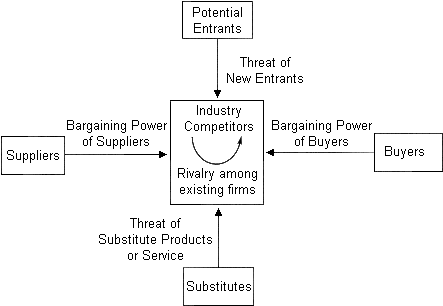
What is the Five Forces model of Porter?
The Five Forces model of Porter is an Outside-in business unit strategy tool that is used to make an analysis of the attractiveness (value) of an industry structure. The Competitive Forces analysis is made by the identification of 5 fundamental competitive forces:
1. Entry of competitors. (How easy or difficult is it for new entrants to start competing, which barriers do exist).
2. Threat of substitutes. (How easy can a product or service be substituted, especially made cheaper).
3. Bargaining power of buyers. How strong is the position of buyers. (Can they work together in ordering large volumes.This also refers to POWERFUL CUSTOMERS that buy a thing based on their knowledge on that thing for example Amirul buy a computer based on his knowledge on ICT)
4. Bargaining power of suppliers. (How strong is the position of sellers. Do many potential suppliers exist or only few potential suppliers, monopoly?)
5. Rivalry among the existing players. (Does a strong competition between the existing players exist? Is one player very dominant or are all equal in strength and size.)
Threat of New Entrants depends on:
* Economies of scale.
* Capital / investment requirements.
* Customer switching costs.
* Access to industry distribution channels.
* Access to technology.
* Brand loyalty. Are customers loyal?
* The likelihood of retaliation from existing industry players.
* Government regulations. Can new entrants get subsidies?
Threat of Substitutes depends on:
* Quality. Is a substitute better?
* Buyers' willingness to substitute.
* The relative price and performance of substitutes.
* The costs of switching to substitutes. Is it easy to change to another product?
Bargaining Power of Suppliers depends on:
* Concentration of suppliers. Are there many buyers and few dominant suppliers?
* Branding. Is the brand of the supplier strong?
* Profitability of suppliers. Are suppliers forced to raise prices?
* Suppliers threaten to integrate forward into the industry (for example: brand manufacturers threatening to set up their own retail outlets).
* Buyers do not threaten to integrate backwards into supply.
* Role of quality and service.
* The industry is not a key customer group to the suppliers.
* Switching costs. Is it easy for suppliers to find new customers?
Bargaining Power of Buyers depends on:
* Concentration of buyers. Are there a few dominant buyers and many sellers in the industry?
* Differentiation. Are products standardized?
* Profitability of buyers. Are buyers forced to be tough?
* Role of quality and service.
* Threat of backward and forward integration into the industry.
* Switching costs. Is it easy for buyers to switch their supplier?
Intensity of Rivalry depends on:
* The structure of competition. Rivalry will be more intense if there are lots of small or equally sized competitors; rivalry will be less if an industry has a clear market leader.
* The structure of industry costs. Industries with high fixed costs encourage competitors to manufacture at full capacity by cutting prices if needed.
* Degree of product differentiation. Industries where products are commodities (e.g. steel, coal) typically have greater rivalry.
* Switching costs. Rivalry is reduced when buyers have high switching costs.
* Strategic objectives. If competitors pursue aggressive growth strategies, rivalry will be more intense. If competitors are merely "milking" profits in a mature industry, the degree of rivalry is typically low.
* Exit barriers. When barriers to leaving an industry are high, competitors tend to exhibit greater rivalry.
(Adapted from http://www.valuebasedmanagement.net/methods_porter_five_forces.html.. Just for reference madam..I'm not doing plaquarize...hehe)
Strategic Analysis of Intel Corporation
Using Porter's framework to determine the impact of current competitors, potential entrants,Buyers,suppliers, and potential substitutes to compared this gigantic company(This all based on my research on the website,maybe have plaguarize it a bit..hehe):
Current Competitors: Intel has many Strategic Business Units, but only two were common to us—Microprocessor manufacturing and Chipset manufacturing. From the perspective of the Microprocessor SBU(Standard Build Unit) , only one true competitor remains: Advanced Micro Devices. Having vanquished all other microprocessor developers such as Cyrix and Nexgen , Intel's only real competition comes from the developers of the Athlon,Thunderird, and Sledgehammer CPUs.
Designed for high-end processing and placed in direct competition with Intel's Pentium III and Pentium IV CPUs, AMD's new processors pose a significant threat to Intel in many different ways. First, AMD has successfully stolen market share from Intel over the last few years (albeit mostly due to shabby management on Intel's part). Second, AMD has succeeded in proving itself as a true PC platform alternative; until its pre-Pentium-IV Athlon became the first CPU to pass the 1.0 GHz mark, many failed to consider AMD as a true contender for the high-end workstation and server market. But beating Intel to 1.0 Gigahertz had an incredible affect on the industry, encouraging many manufacturers to start carrying AMD-powered machines, thus opening a great deal more of the market originally dominated by Intel.(Great rite..)
But AMD's luck was short-lived. Intel immediately fired back, reclaiming the "fastest processor" title with a later iteration of its Pentium line, and using mafia-like (and ethically questionable) marketing tactics to encourage computer manufacturers to stop carrying AMD processors. The manufacturers capitulated, and eventually almost all of the major computer brands were again Intel-only.(That's cheated but it's all bout business strategy)
Intel's aggressive comeback against AMD has not been without its costs, however. By slashing margins to entice computer manufacturers into exclusive contracts, the firm regained much of its lost market share at the cost of profits. However, a price war between a gigantic company like Intel and a relatively tiny company like AMD shouldn't last long. Intel certainly has deep enough pockets to keep the squeeze on AMD for some time.
The outlook for the Chipset SBU is somewhat similar. With only one real competitor—VIA Technologies, a critical partner with AMD who manufacturers Athlon-compatible chipsets—Intel once again finds itself in the position of Cat vs Mouse(Like Tom And Jerry..Hahaha). Although not mentioned in the text, VIA's Motherboards and chipsets are considered by most to be far inferior to those developed by Intel. In fact, the requirement that one use a VIA motherboard (rather than one developed by Intel) with an Athlon processor has caused many users to shy away from AMD altogether. Often, bugs arise from faulty VIA chipsets and motherboards, and the "AMD Architecture" gets the blame, despite AMD's lack of responsibility. Still, without AMD there would probably be no VIA—and without VIA, AMD would have to develop and manufacture its own chipset—something it probably cannot afford to do. Thus the fate of these two companies is hopelessly intertwined; when attacks by Intel weaken one company, in reality, they weaken both(The AMD and VIA companies).
Potential Entrants: None, nor should we expect to see any soon.The capital expanditures required to develop and manufacture microprocessors and chipsets is enermous—an insurmountable entry barrier for almost any company that would like to join the fray. Companies wishing to enter this industry need only to look at one of Intel's multi-billion-dollar chip fabrication plants before s/he will undoubtedly find some other industry to invade.(This statement I completely plaguarize...)
Buyers: Buyers include end-user home computer builders and small "PC-Clone" shops that build customized machines in most cities. But large computer manufacturers such as Dell, Gateway, and Hewlett-Packard(HP) account for the vast majority of chipset and microprocessor purchases. Buyer power in this industry has fluctuated from time to time, but for the most part, the "Intel Inside" logo has been considered by most manufacturers to be too important to forgo(to pass by). Until the Athlon made a serious challenge to Intel's prime markets, buyers simply had nowhere else to turn for microprocessors. Until the Athlon, buyers had to choose between pricey-but-respected Intel chips or chips by AMD that cheaper and a bit same performance like Intel, considered by most to be inferior to their Intel counterparts.
Buyer Power increased sharply when this new option arrived—manufacturers actually had more than one company from which to buy CPUs! However, buyer power has markedly diminished since that time due to exclusive contracts and pressure from Intel to keep AMD out of their machines.
Suppliers: Intel's suppliers are not mentioned in the text, but it is safe to assume that the company's suppliers have the same lack of selling power as other commodity brokers in the tech industry. Intel's raw materials—silicon, semiconductors, and the like—can be purchased from a litany of manufacturers, thus affording the firm a great deal of buyer power in selecting with whom to do business.
Potential Substitutes: While other companies do manufacture competing server/workstation platforms (such as Sun Microsystems and Digital Electronics, before the latter was purchased by Compaq), these companies only compete in a limited number of arenas. The most powerful Windows/Intel server is far less powerful than most Sun Microsystems machines, but they are also far less expensive. One might argue that comparing Intel/Windows machines to Sun/UNIX machines is much like comparing a nail file to a hacksaw—the analogy is simply inappropriate. Regardless, while Intel's customers (such as Dell and Compaq) might compete on a limited basis with companies like Sun, Intel's only fear of substitution comes from AMD...and the occasional abacus*.(Cina say it as Sempoa).
With that being said, one might hope to identify some of Intel's core compentecies and competitive advantages. Certainly, Intel's position as the "gold standard" for PC architectures must be counted among the company's competitive advantages. When Intel decided to switch from "socket" to "slot" processors, the industry (including AMD) followed suit. When the new "slot" architecture was found to be unwieldy, Intel switched back to sockets—and the industry followed once again. By serving basically as "the R&D for the entire computing industry," Intel is able to steer trends and technologies in ways that best benefit the itself.
As the conclusion,Intel as the gigantic company has manipulated the five forces model to remain as the bestest producer of its products.........The end!!



2 comments:
good...4/5
mis good jeke aisshhh
Post a Comment